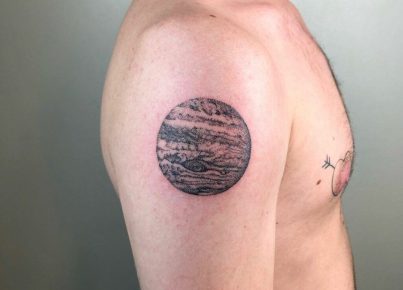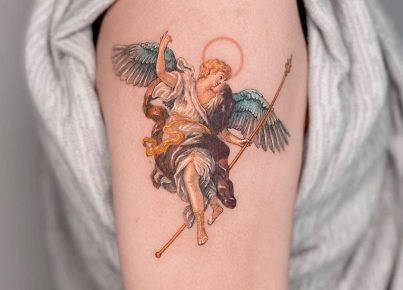Duncan Whitfield is a talented realism tattooer working out of Southampton, U.K.
He mainly specializes in creating built-to-last portrait work, and is incredibly methodical about the entire process.
In this interview, I got the opportunity to talk with him about things such as the relationship between photography and tattooing, what makes a good reference photo and what does not, tattooing and mental health, and more.
Hope you guys enjoy the read, thanks for looking.
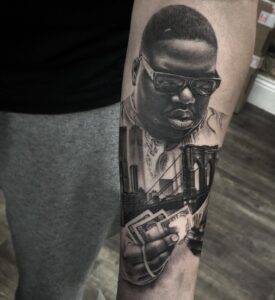
So I know that you are into wildlife photography, and like to incorporate it into your references. Can you talk a little bit about what goes on behind the scenes with all of that? What is the relationship you see between photography and tattooing?
I am a keen wildlife photographer, particularly birds. I’ve always had an interest in them ever since I was a kid. I believe that knowing how birds behave and interact with each other helps when it comes to composition. To make it believable. I like to use my photographs wherever I can as I get a real sense of achievement from taking a photograph right through to a completed tattoo. It means there’s a much more personal touch to the tattoo for the client as well.
Birds have to be one of the hardest things to photograph though. There are so many factors that have to be considered. There’s the knowledge of your camera equipment, geography, weather, species, time of day, timing and luck. Everything has to align just right to get the perfect shot off. Then the subject has to play ball. It has to be close enough, the right position and of course the lighting has to be right. Of all the photos I’ve taken, not as many as I would like have ended up as tattoos. It’s an ongoing journey. One that is really rewarding.
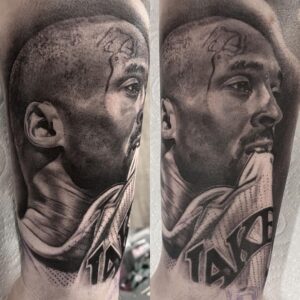
On that same subject, what makes a good reference photo for a tattoo, and vice versa – what characteristics of a photo tell you that it would NOT make a good tattoo?
Ultimately it will come down to contrast and emotion. With a portrait that will be a facial expression and with wildlife that’s likely to be movement. And in both instances, the eye level/contact with the lens can clinch one image over another.
In a portrait you don’t want an image that when converted to black-and-white has no contrast and appears flat. There are things I can do to adjust the levels and values to suit but I would only go so far before it will start to look odd and not translate well to a tattoo. I always push provisional clients to provide me with the best reference before I book them in for an appointment. I believe that not all portraits should be tattooed. I’m always very upfront with regards to this. Just because an image makes a good photograph, does not mean it will make a good tattoo. It is always worth pushing back for better reference when it comes to personal portraits. Ultimately you want the very best result. I don’t expect prospective clients to understand this criteria before they engage with me, it is my job to guide them towards the best possible outcome. This should be the case for any tattooist taking on portraits in my opinion.
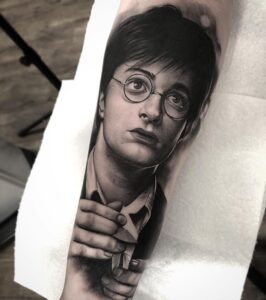
I also know that you used to be a professional graphic designer. In what ways has that given you a leg up on your tattooing career? What’s one really important thing to keep in mind when working on something digitally to be incorporated into a tattoo?
I was a graphic designer for 13 years. That time spent behind a computer designing promotional material in the corporate world has given me an invaluable knowledge of digital image manipulation platforms. Predominantly Photoshop and illustrator. Both of which have proved to be my day to day staple when it comes to tattoo composition. Composition itself is such a huge part of graphic design that it was only natural that the experience in this field would translate well and benefit tattoo design.
One thing it is really important to remember when creating digital stencils is to pay attention to the dpi. If you’re making a line drawing over a 72dpi image that is say only 100mm square and you need to print it to fit A4 size, you’re going to end up with blurred lines when printed to make a stencil as you’ll have to enlarge the image over 200% to make it big enough. Make sure the image you are using is physically big enough to pull it off. Oh and of course pay attention to which layer you’re drawing on! We’ve all been caught out by that!
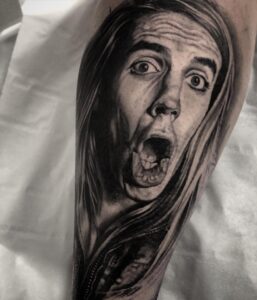
Aside from the physical toll it must take on your body day after day, what have you found to be the most challenging part of being a tattoo artist?
I would say time. There’s never enough time. It can be all consuming. Design. Clean. Set up. Tattoo. Clear up. Clean. Admin. When you’re all in, you’re committed. I have a better balance now but for a long time I was just blinkered. Personal relationships definitely suffered. Both at home and at work. I have to take a large part of the blame for that for sure. But it’s an easy situation to find yourself in, you know? When things are going well. Ferris Bueller was right though, You do need to stop and take a look around once in while.
If the Covid-19 situation has taught us anything, for me, it would be that it’s dangerous to be all consumed by one thing. Because if you take that away, you’re left with nothing. Thankfully I have a million hobbies and interests to keep me occupied…oh and a wife… and a daughter to squabble with… and of course anyone following me on instagram will have seen my dog; José feature in my stories I’m sure!
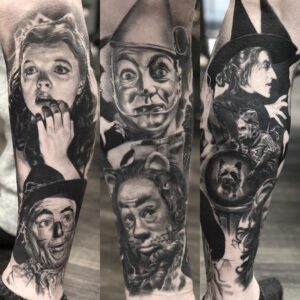
How about the most rewarding part?
I think it’s with the personal portraits of recently lost loved ones and pets. There’s definitely been some emotional moments with clients with the big reveal. It has to be that or what I touched on in the first question. Taking a photo out in nature and bringing it right through to a finished tattoo.
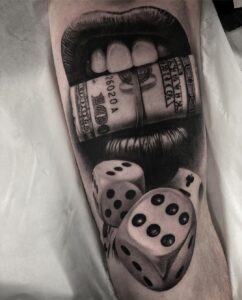
If you could now go back to when you first started tattooing and tell yourself three important things you wish you knew back then, what might those be?
Not to teach yourself to tattoo for one. Like I did. It’s a much longer laborious process than an apprenticeship. It was a means to an end for me but I would always recommend an apprenticeship now. You’ll grow faster and with authenticity.
Give yourself a break, don’t say yes to everything just to please other people. It’s so easy to burn out and it creeps up on you. You can’t please everyone. Trying to is the quickest route to failure. Don’t worry about booking yourself too far ahead. I know this can be a bit of an obsession for security in the early days but it can quickly get out of hand and before you know it you’re working 6 day weeks with no breaks.
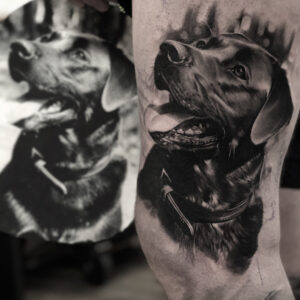
What about three things you wish each of your clients/collectors knew, in order to save you both the headaches?
Approach enquiring about a tattoo as you would any other professional service. DM-ing me with ‘Hey Bro, I wanna get tatted ASAP. I’m desperate bro. Get me in bro.” will just get your message deleted. There seems to be a direct correlation between not following instructions and then radio silence if you do reply to that request. Many artists are very busy and it’s disheartening to answer requests to ghosting so you quickly develop a sixth sense to time wasters. It’s not meant to cause offense to prospective clients, it’s more about protecting your own mental resolve. There’s only so many minutes in a day and we have to make them as productive as possible. I take all my enquiries via email so there is a paper trail of the conversation. It definitely avoids confusion. My advice is keep communication to one platform.
Pay attention to the style in which the artist you’re enquiring with, works. Is what you’re asking for going to suit their style? If someone emails me with a request that’s not suited to me I’ll always try and match them up with another artist better suited.
Always state the position of the tattoo, ideally a photo of the area and as much reference/information as possible. Steer clear of sending an essay with very specific instructions of how it MUST all fit together. A good clear idea will suffice.
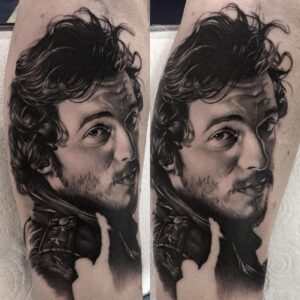
How has tattooing impacted your mental health? If you feel inclined, maybe list a few pros and a few cons.
I would say at times tattooing has had a profound affect on my mental health. With regards to emotional pressures and the conflict between business and relationships. I didn’t see either coming at the time. I do a lot of memorial portraits and one particular week I took on 3 very recent bereavements and 2 memorial pet portraits all in the space of 5 days. That actually hit me harder than I expected. I was already suffering from mild depression at the time and that was definitely a trigger. I now try to never book too many together and have breaks in between. That would be something I would advise to anyone.
Its very easy to get burned out when you’re working 6 days a week. There’s more demand on your time than you bargain for when you have a bit of a waiting list. You want to keep everyone happy, your clients and personal relationships alike. It’s a balancing act I definitely got it wrong at times. I’ve brought my waiting list down now just so I can see the wood for the trees. I always keep a week free every month. It allows me to have space to move people if I need to, take time off or at the very least I know there’s a fire break not too far away. It also allows you to take on projects you’d like to do that you might miss out on if you’re booked solid for a year. I always advise artists new into the industry to be careful not to over book. It’s all about security in the early days when you’re building a profile for yourself. But that becomes a bit of a trap quite quickly.
I’ve now managed to separate tattooing from home life more successfully. I try and keep the 2 as separate as possible. For me, that’s important.
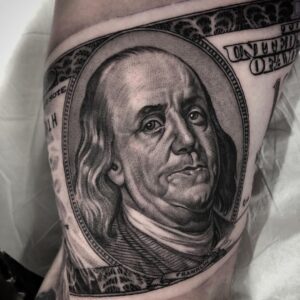
Tattooing has blown up since the age of social media. In what ways do you expect to see the industry to change over the course of the next few years? What do you hope to see?
Im really not sure. I could see more private studios cropping up. Social media has allowed people to gain a client base with less reliance for the need of exposure gained working in a highstreet outfit that would have been needed before ‘the Gram’ hit the scene. A smaller more intimate space will have much lower overheads. On the flip side, the social dynamic in a bigger studio is more conducive to creativity I find. I like to bounce ideas off of other artists when I can. You grow slower on your own. You have to work harder for inspiration.
As far as what I’d like to see? I’d like to see easier travel options for artists. I don’t know how it would work logistically, with regards to visas etc but a more official, easier way of working abroad would be awesome. To see the industry recognised for the progressive art form that it is. Acceptance has come a long way but there’s always room for improvement.
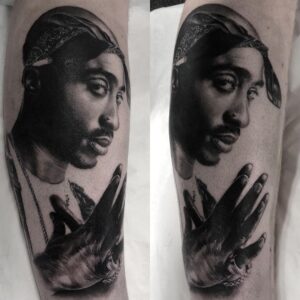
And lastly…I’m always curious about these two things: how might you prepare for your typical full day session (I can imagine they must be very tiring), and what’s usually going through your mind as you work on each tattoo?
As I mentioned about keeping tattooing separate from home life, I usually do most of my design work in the studio. I ‘try’ to get into the studio for 08:30 after dropping my daughter at school and my dog at day care and arrange for clients to arrive for 10:30/11. That gives 2-2hr:30mins to prepare for the day. I’m big on the client experience. I want clients to leave having had a great day even if the tattoo hurt like hell! I think good entertainment is vital for client comfort and makes a huge difference to how well people sit. I’ve only ever had 4 people pass out on me and I believe that’s all down to the environment you provide the client with. Nervous first time clients need time to acclimatise in my opinion. I delay being ready for them so they have time to get into a film and relax with a hot drink and snacks. As far as what’s going through my mind? Just about everything! Ha! I’m very methodical once I start tattooing. The design process is the creative bit for me, the tattooing is the idea execution. I’m quite relaxed once I start.
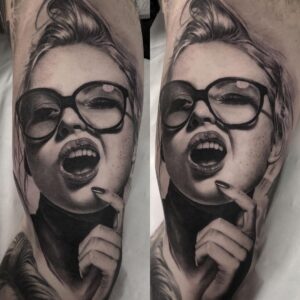
Thanks to anyone who took the time to read/look, hope you guys enjoyed the write-up.
Be sure to follow Duncan on Instagram @duncanwhitfield.
Thanks again for your time man!


